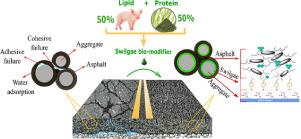Resources, Conservation and Recycling ( IF 11.2 ) Pub Date : 2021-03-30 , DOI: 10.1016/j.resconrec.2021.105576 Farideh Pahlavan , Daniel Oldham , Sheyda Shakiba , Stacey Louie , Elham Fini

|
Low resistant to water damage is a major concern in bituminous composites used in roads and roofs. Water damage is attributed to desorption of molecules which are pre-adsorbed to siliceous stone mainly due to the water molecules' higher affinity to active sites of siliceous substrates. This paper shows feasibility of engineering highly water-resistant bio-modifiers from a hybrid biomass feedstock containing a balanced combination of protein and lipid. In the present study, this concept is illustrated by synthesizing a novel bio-modifier referred to as Swilgae from coliquefaction of high-protein algae (A) with high-lipid swine manure (S) for use in bituminous composites. To examine efficacy of Swilgae bio-modifier to enhance bitumen's resistance to water damage, this paper specifically studies adsorption and de-wetting of Swilgae molecules from siliceous substrates as surrogates for quartz and granite stones used in bituminous composites. To do so, we use computational modeling geared toward the use of density functional theory (DFT) combined with laboratory experiments using a moisture-induced shear-thinning test and in-situ Fourier transform infrared (FTIR) spectroscopy. The study results showed that Swilgae bio-modifier is more effective at improving the asphalt resistance to moisture damage than those made from either algae or manure individually, owing to the synergy between lipid-rich swine manure combined with protein-rich algae. This was evidenced in bitumen containing 1A:1S Swilgae showing the least change in the moisture-induced shear thinning among all studied scenarios. This was attributed to the molecular structures of the Swilgae having both lower polarizability and higher adsorption energy per unit area of siliceous surface compared to those made from isolated feedstock. Additionally, Swilgae showed to passivate the active sites of silica and replace water molecules over the silica surface via a competitive adsorption with the water molecules on the hydroxylated silica surface that is consistent with the FTIR results. Therefore, 1A:1S Swilgae molecules build a well-structured bridge between bitumen and siliceous substrates, leading to improved adhesive forces and subsequently enhaced durability in the bituminous composites used in roads and roofs.
中文翻译:

富含蛋白质的生物废料:一种可行的原料,可用于制造耐用的生物粘合剂,用于沥青复合材料
对水损害的低抵抗力是用于道路和屋顶的沥青复合材料的主要问题。水损害归因于预先吸附到硅质石上的分子的解吸,这主要是因为水分子对硅质底物的活性位点具有更高的亲和力。本文显示了从包含蛋白质和脂质平衡组合的混合生物质原料中工程化高抗水生物改性剂的可行性。在本研究中,通过从高蛋白藻类(A)与高脂猪粪(S)的大肠杆菌液化合成一种新型生物修饰剂Swilgae来说明这一概念,以用于沥青复合材料。要检查Swilgae生物改性剂增强沥青对水的抵抗力的功效,本文专门研究了硅质基质中Swilgae分子的吸附和脱湿,作为沥青和沥青复合材料中使用的石英和花岗岩石的替代物。为此,我们采用针对密度泛函理论(DFT)的计算模型,并结合使用水分诱导的剪切稀化试验和原位傅立叶变换红外(FTIR)光谱。研究结果表明,由于富含脂质的猪粪肥与富含蛋白质的藻类之间的协同作用,Swilgae生物改性剂比单独由藻类或肥料制成的沥青在改善沥青的耐湿气破坏性方面更有效。这在包含1A:1S Swilgae的沥青中得到了证明,在所有研究的方案中,水分引起的剪切稀化的变化最小。这归因于与由分离的原料制成的那些相比,Swilgae的分子结构具有更低的极化率和更高的每单位面积硅质表面的吸附能。此外,Swilgae证明可以钝化二氧化硅的活性位点,并通过与羟基化二氧化硅表面上的水分子竞争吸附来替代二氧化硅表面上的水分子,这与FTIR结果一致。因此,1A:1S Swilgae分子在沥青和硅质基材之间建立了结构良好的桥梁,从而改善了粘合力,并随后提高了道路和屋顶所用沥青复合材料的耐久性。











































 京公网安备 11010802027423号
京公网安备 11010802027423号